中国伞形科植物新记录
- 格式:pdf
- 大小:617.40 KB
- 文档页数:4
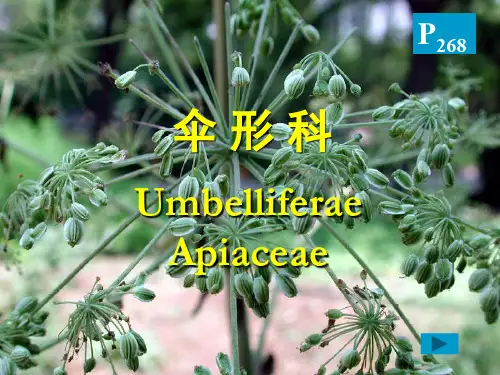

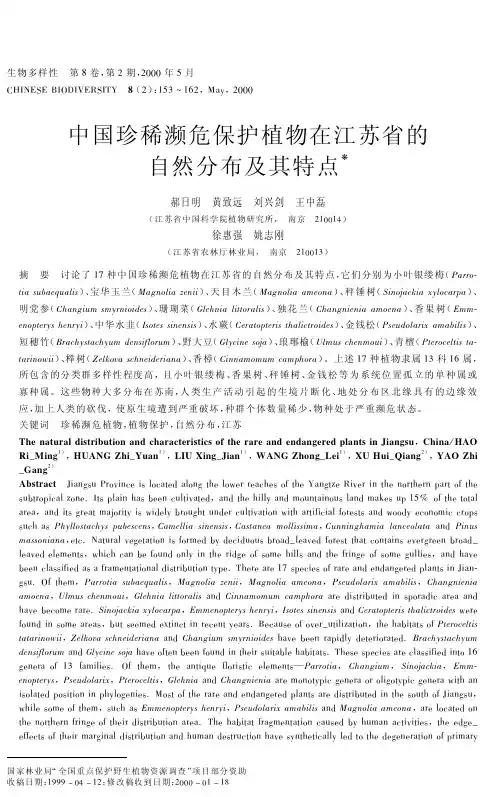
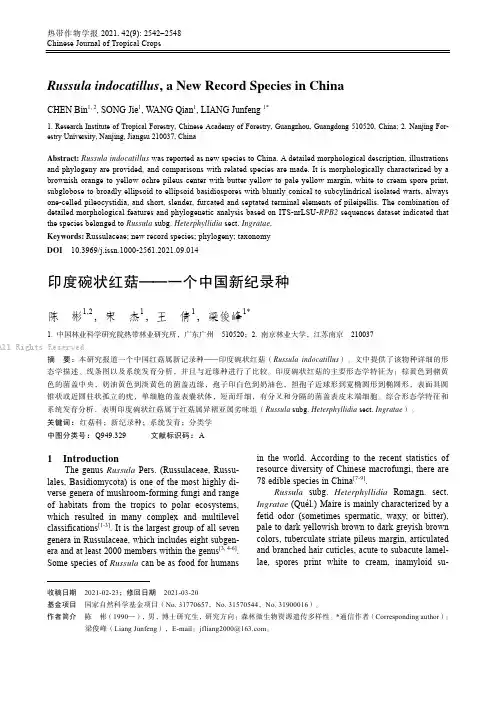
热带作物学报2021, 42(9): 2542 2548 Chinese Journal of Tropical Crops收稿日期 2021-02-23;修回日期 2021-03-20基金项目 国家自然科学基金项目(No. 31770657,No. 31570544,No. 31900016)。
作者简介 陈 彬(1990—),男,博士研究生,研究方向:森林微生物资源遗传多样性。
*通信作者(Corresponding author ):梁俊峰(Liang Junfeng ),E-mail :*******************。
Russula indocatillus , a New Record Species in ChinaCHEN Bin 1, 2, SONG Jie 1, WANG Qian 1, LIANG Junfeng 1*1. Research Institute of Tropical Forestry, Chinese Academy of Forestry, Guangzhou, Guangdong 510520, China;2. Nanjing For-estry University, Nanjing, Jiangsu 210037, ChinaAbstract: Russula indocatillus was reported as new species to China. A detailed morphological description, illustrations and phylogeny are provided, and comparisons with related species are made. It is morphologically characterized by a brownish orange to yellow ochre pileus center with butter yellow to pale yellow margin, white to cream spore print, subglobose to broadly ellipsoid to ellipsoid basidiospores with bluntly conical to subcylindrical isolated warts, always one-celled pileocystidia, and short, slender, furcated and septated terminal elements of pileipellis. The combination of detailed morphological features and phylogenetic analysis based on ITS-nrLSU-RPB2 sequences dataset indicated that the species belonged to Russula subg. Heterphyllidia sect. Ingratae . Keywords: Russulaceae; new record species; phylogeny; taxonomy DOI 10.3969/j.issn.1000-2561.2021.09.014印度碗状红菇——一个中国新纪录种陈 彬1,2,宋 杰1,王 倩1,梁俊峰1*1. 中国林业科学研究院热带林业研究所,广东广州 510520;2. 南京林业大学,江苏南京 210037摘 要:本研究报道一个中国红菇属新记录种——印度碗状红菇(Russula indocatillus )。
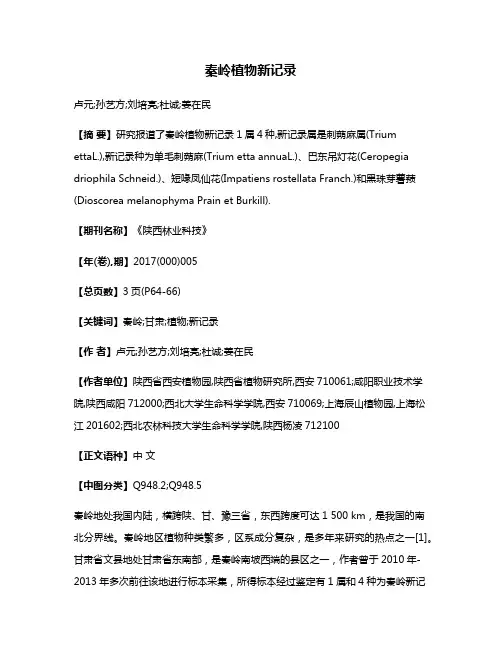
秦岭植物新记录卢元;孙艺方;刘培亮;杜诚;姜在民【摘要】研究报道了秦岭植物新记录1属4种,新记录属是刺蒴麻属(Trium ettaL.),新记录种为单毛刺蒴麻(Trium etta annuaL.)、巴东吊灯花(Ceropegia driophila Schneid.)、短喙凤仙花(Impatiens rostellata Franch.)和黑珠芽薯蓣(Dioscorea melanophyma Prain et Burkill).【期刊名称】《陕西林业科技》【年(卷),期】2017(000)005【总页数】3页(P64-66)【关键词】秦岭;甘肃;植物;新记录【作者】卢元;孙艺方;刘培亮;杜诚;姜在民【作者单位】陕西省西安植物园,陕西省植物研究所,西安710061;咸阳职业技术学院,陕西咸阳712000;西北大学生命科学学院,西安710069;上海辰山植物园,上海松江201602;西北农林科技大学生命科学学院,陕西杨凌712100【正文语种】中文【中图分类】Q948.2;Q948.5秦岭地处我国内陆,横跨陕、甘、豫三省,东西跨度可达1 500 km,是我国的南北分界线。
秦岭地区植物种类繁多,区系成分复杂,是多年来研究的热点之一[1]。
甘肃省文县地处甘肃省东南部,是秦岭南坡西端的县区之一,作者曾于2010年-2013年多次前往该地进行标本采集,所得标本经过鉴定有1属和4种为秦岭新记录,其中有部分类群为甘肃省新记录,现予以报道,所有凭证标本均保存于西北农林科技大学植物标本馆(WUK)。
刺蒴麻属Triumfetta L. , Sp. Pl. 1: 444. 1753; Fl. Reipubl. Popularis Sin.49(1):105. 1989; Flora of China 12:258.2007.(椴树科 Tiliaceae)本属是直立或匍匐草本或为亚灌木,全世界大约有100种左右,主要分布在热带和亚热带地区;我国已知有7种,主要分布在秦岭以南各省区[2, 3]。
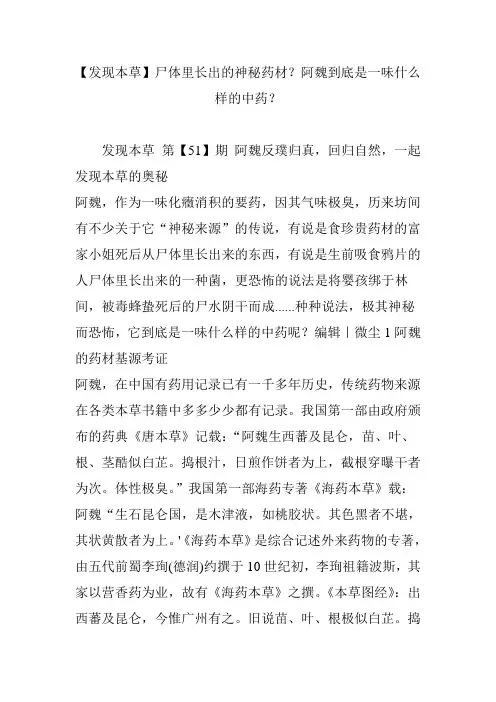
【发现本草】尸体里长出的神秘药材?阿魏到底是一味什么样的中药?发现本草第【51】期阿魏反璞归真,回归自然,一起发现本草的奥秘阿魏,作为一味化癥消积的要药,因其气味极臭,历来坊间有不少关于它“神秘来源”的传说,有说是食珍贵药材的富家小姐死后从尸体里长出来的东西,有说是生前吸食鸦片的人尸体里长出来的一种菌,更恐怖的说法是将婴孩绑于林间,被毒蜂蛰死后的尸水阴干而成......种种说法,极其神秘而恐怖,它到底是一味什么样的中药呢?编辑|微尘1阿魏的药材基源考证阿魏,在中国有药用记录已有一千多年历史,传统药物来源在各类本草书籍中多多少少都有记录。
我国第一部由政府颁布的药典《唐本草》记载:“阿魏生西蕃及昆仑,苗、叶、根、茎酷似白芷。
捣根汁,日煎作饼者为上,截根穿曝干者为次。
体性极臭。
”我国第一部海药专著《海药本草》载:阿魏“生石昆仑国,是木津液,如桃胶状。
其色黑者不堪,其状黄散者为上。
'《海药本草》是综合记述外来药物的专著,由五代前蜀李珣(德润)约撰于10世纪初,李珣祖籍波斯,其家以营香药为业,故有《海药本草》之撰。
《本草图经》:出西蕃及昆仑,今惟广州有之。
旧说苗、叶、根极似白芷。
捣根汁,日煎作饼者为上,截根穿曝干者为次。
今广州出者,云是木膏液滴酿结成。
二说不同。
谨按段成式《酉阳杂俎》云∶阿魏木,生波斯国,呼为阿虞木,长八、九尺,皮色青黄;三月生叶,似鼠耳,无花实;断其枝,汁出如饴,久乃坚凝,名阿魏。
或云取其汁和米、豆屑,合酿而成,乃与今广州所上相近耳。
《雷公炮制药性解》:“产波斯国阿虞木内之脂也。
”《玉揪药解》:“阿魏生西番昆仑地,是木汁坚凝成冰,松脂渍胶,臭恶异常。
”《本草分经》:“西番木脂熬成,今以胡蒜白伪之。
”...... 现行《中国药典》-阿魏:“本品为伞形科植物新疆阿魏Ferula sinkiangensis K. M.Shen 或阜康阿魏Ferula fukanensis K. M. Shen 的树脂。
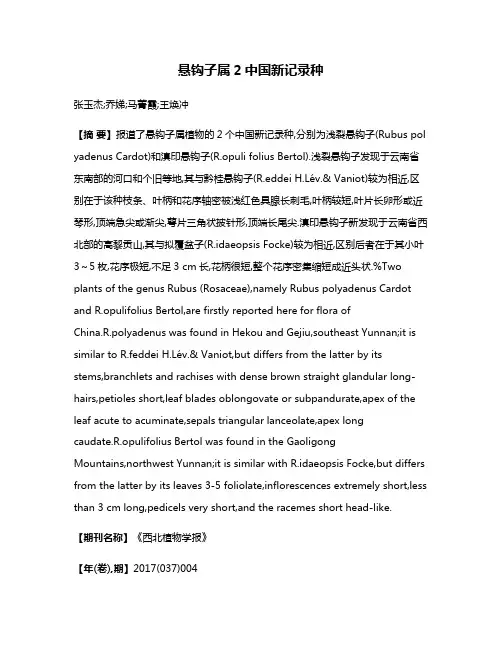
悬钩子属2中国新记录种张玉杰;乔娣;马菁霞;王焕冲【摘要】报道了悬钩子属植物的2个中国新记录种,分别为浅裂悬钩子(Rubus pol yadenus Cardot)和滇印悬钩子(R.opuli folius Bertol).浅裂悬钩子发现于云南省东南部的河口和个旧等地,其与黔桂悬钩子(R.eddei H.Lév.& Vaniot)较为相近,区别在于该种枝条、叶柄和花序轴密被浅红色具腺长刺毛,叶柄较短,叶片长卵形或近琴形,顶端急尖或渐尖,萼片三角状披针形,顶端长尾尖.滇印悬钩子新发现于云南省西北部的高黎贡山,其与拟覆盆子(R.idaeopsis Focke)较为相近,区别后者在于其小叶3~5枚,花序极短,不足3 cm长,花柄很短,整个花序密集缩短成近头状.%Two plants of the genus Rubus (Rosaceae),namely Rubus polyadenus Cardot and R.opulifolius Bertol,are firstly reported here for flora ofChina.R.polyadenus was found in Hekou and Gejiu,southeast Yunnan;it is similar to R.feddei H.Lév.& Vaniot,but differs from the latter by its stems,branchlets and rachises with dense brown straight glandular long-hairs,petioles short,leaf blades oblongovate or subpandurate,apex of the leaf acute to acuminate,sepals triangular lanceolate,apex long caudate.R.opulifolius Bertol was found in the GaoligongMountains,northwest Yunnan;it is similar with R.idaeopsis Focke,but differs from the latter by its leaves 3-5 foliolate,inflorescences extremely short,less than 3 cm long,pedicels very short,and the racemes short head-like.【期刊名称】《西北植物学报》【年(卷),期】2017(037)004【总页数】4页(P805-808)【关键词】新分布;浅裂悬钩子;滇印悬钩子;悬钩子属;中国【作者】张玉杰;乔娣;马菁霞;王焕冲【作者单位】云南大学生命科学学院,昆明650091;云南大学生命科学学院,昆明650091;云南大学生命科学学院,昆明650091;云南大学生命科学学院,昆明650091【正文语种】中文【中图分类】Q949.751.8悬钩子属(Rubus L.)是蔷薇科最大的属之一,属于蔷薇亚科悬钩子族(Rubeae)[1],全属约有700余种[2-3],广布于全世界除南极以外区域,地理北界达北极圈附近,南界可达智利南部的福克兰群岛[4]。
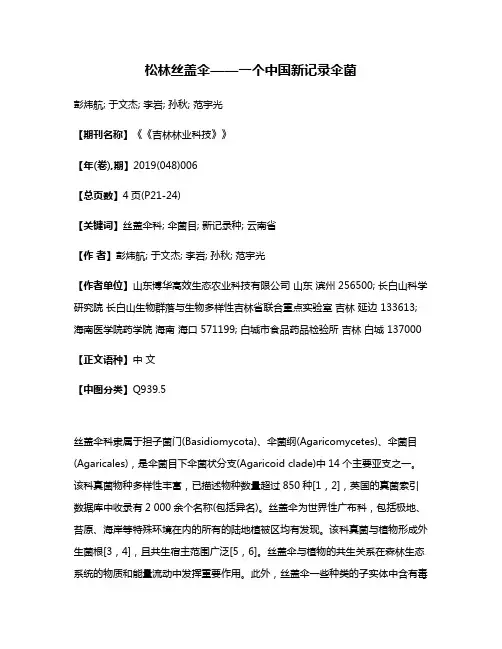
松林丝盖伞——一个中国新记录伞菌彭炜航; 于文杰; 李岩; 孙秋; 范宇光【期刊名称】《《吉林林业科技》》【年(卷),期】2019(048)006【总页数】4页(P21-24)【关键词】丝盖伞科; 伞菌目; 新记录种; 云南省【作者】彭炜航; 于文杰; 李岩; 孙秋; 范宇光【作者单位】山东博华高效生态农业科技有限公司山东滨州 256500; 长白山科学研究院长白山生物群落与生物多样性吉林省联合重点实验室吉林延边 133613; 海南医学院药学院海南海口 571199; 白城市食品药品检验所吉林白城 137000【正文语种】中文【中图分类】Q939.5丝盖伞科隶属于担子菌门(Basidiomycota)、伞菌纲(Agaricomycetes)、伞菌目(Agaricales),是伞菌目下伞菌状分支(Agaricoid clade)中14个主要亚支之一。
该科真菌物种多样性丰富,已描述物种数量超过850种[1,2],英国的真菌索引数据库中收录有2 000余个名称(包括异名)。
丝盖伞为世界性广布科,包括极地、苔原、海岸等特殊环境在内的所有的陆地植被区均有发现。
该科真菌与植物形成外生菌根[3,4],且共生宿主范围广泛[5,6]。
丝盖伞与植物的共生关系在森林生态系统的物质和能量流动中发挥重要作用。
此外,丝盖伞一些种类的子实体中含有毒蝇碱或裸盖菇素[7],误食丝盖伞会引发中毒症状,严重者不及时抢救可导致死亡[8]。
中国丝盖伞科的物种多样性研究始于20世纪,但研究基础相对薄弱,仅吉林省和广东省有过系统性报道[9,10]。
过去十年,在对全国进行丝盖伞科物种多样性调查过程中,我们发现了一系列新种和新记录种[11-13],本文报道在云南省发现一个中国新记录种,经形态研究和DNA序列分析的基础上确定为松林丝盖伞(新拟)(Inocybe soluta Velen.)。
1 材料和方法1.1 研究材料研究用标本于2015年采自云南省楚雄彝族自治州紫溪山自然保护区,在野外原生境拍摄生态照片,将新鲜标本带回住处后记录其形态特征,预留分子材料。
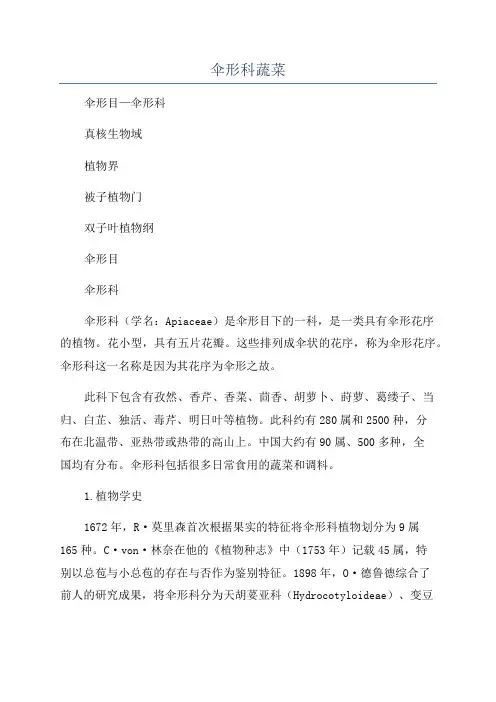
伞形科蔬菜伞形目—伞形科真核生物域植物界被子植物门双子叶植物纲伞形目伞形科伞形科(学名:Apiaceae)是伞形目下的一科,是一类具有伞形花序的植物。
花小型,具有五片花瓣。
这些排列成伞状的花序,称为伞形花序。
伞形科这一名称是因为其花序为伞形之故。
此科下包含有孜然、香芹、香菜、茴香、胡萝卜、莳萝、葛缕子、当归、白芷、独活、毒芹、明日叶等植物。
此科约有280属和2500种,分布在北温带、亚热带或热带的高山上。
中国大约有90属、500多种,全国均有分布。
伞形科包括很多日常食用的蔬菜和调料。
1.植物学史1672年,R·莫里森首次根据果实的特征将伞形科植物划分为9属165种。
C·von·林奈在他的《植物种志》中(1753年)记载45属,特别以总苞与小总苞的存在与否作为鉴别特征。
1898年,O·德鲁德综合了前人的研究成果,将伞形科分为天胡荽亚科(Hydrocotyloideae)、变豆菜亚科(Saniculoideae)和芹亚科(Apioideae)3个科。
这个系统为世界学者广泛应用。
2.形态特征一年生至多年生草本,很少是矮小的灌木(在热带与亚热带地区)。
根通常直生,肉质而粗,有时为圆锥形或有分枝自根颈斜出,很少根成束、圆柱形或棒形。
茎直立或匍匐上升,通常圆形,稍有棱和槽,或有钝棱,空心或有髓。
叶互生,叶片通常分裂或多裂,1回掌状分裂或1-4回羽状分裂的复叶,或1-2回三出式羽状分裂的复叶,很少为单叶;叶柄的基部有叶鞘,通常无托叶,稀为膜质。
花小,两性或杂性,成顶生或腋生的复伞形花序或单伞形花序,很少为头状花序;伞形花序的基部有总苞片,全缘、齿裂、很少羽状分裂;小伞形花序的基部有小总苞片,全缘或很少羽状分裂;花萼与子房贴生,萼齿5或无;花瓣5,在花蕾时呈覆瓦状或镊合状排列,基部窄狭,有时成爪或内卷成小囊,顶端钝圆或有内折的小舌片或顶端延长如细线;雄蕊5,与花瓣互生。
子房下位,2室,每室有一个倒悬的胚珠,顶部有盘状或短圆锥状的花柱基;花柱2,直立或外曲,柱头头状。
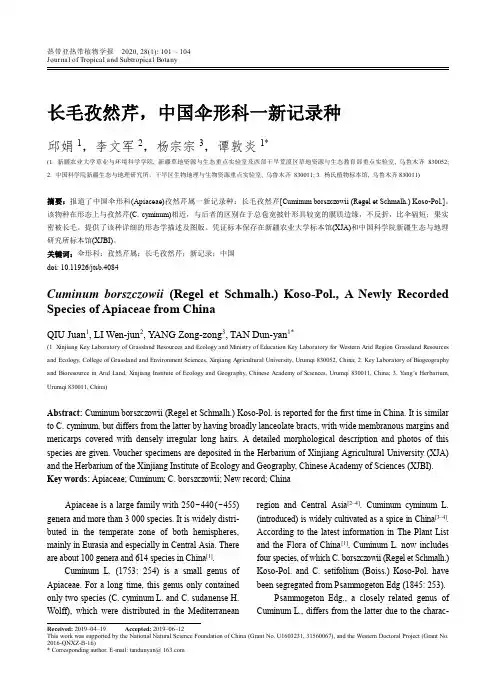
热带亚热带植物学报 2020, 28(1): 101 ~ 104 Journal of Tropical and Subtropical BotanyReceived: 2019–04–19 Accepted: 2019–06–12This work was supported by the National Natural Science Foundation of China (Grant No. U1603231, 31560067), and the Western Doctoral Project (Grant No. 2016-QNXZ-B-16)* Corresponding author. E-mail: tandunyan@ 长毛孜然芹,中国伞形科一新记录种邱娟1,李文军2,杨宗宗3,谭敦炎1*(1. 新疆农业大学草业与环境科学学院, 新疆草地资源与生态重点实验室及西部干旱荒漠区草地资源与生态教育部重点实验室, 乌鲁木齐 830052; 2. 中国科学院新疆生态与地理研究所,干旱区生物地理与生物资源重点实验室, 乌鲁木齐 830011; 3. 杨氏植物标本馆, 乌鲁木齐830011)摘要:报道了中国伞形科(Apiaceae)孜然芹属一新记录种:长毛孜然芹[Cuminum borszczowii (Regel et Schmalh.) Koso-Pol.]。
该物种在形态上与孜然芹(C. cyminum )相近,与后者的区别在于总苞宽披针形具较宽的膜质边缘,不反折,比伞辐短;果实密被长毛。
提供了该种详细的形态学描述及图版。
凭证标本保存在新疆农业大学标本馆(XJA)和中国科学院新疆生态与地理研究所标本馆(XJBI)。
关键词:伞形科;孜然芹属;长毛孜然芹;新记录;中国 doi: 10.11926/jtsb.4084Cuminum borszczowii (Regel et Schmalh.) Koso-Pol., A Newly Recorded Species of Apiaceae from ChinaQIU Juan 1, LI Wen-jun 2, YANG Zong-zong 3, TAN Dun-yan 1*(1. Xinjiang Key Laboratory of Grassland Resources and Ecology and Ministry of Education Key Laboratory for Western Arid Region Grassland Resources and Ecology , College of Grassland and Environment Sciences , Xinjiang Agricultural University , Urumqi 830052, China; 2. Key Laboratory of Biogeography and Bioresource in Arid Land , Xinjiang Institute of Ecology and Geography , Chinese Academy of Sciences , Urumqi 830011, China; 3. Yang ’s Herbarium , Urumqi 830011, China)Abstract: Cuminum borszczowii (Regel et Schmalh.) Koso-Pol. is reported for the first time in China. It is similar to C. cyminum , but differs from the latter by having broadly lanceolate bracts, with wide membranous margins and mericarps covered with densely irregular long hairs. A detailed morphological description and photos of this species are given. Voucher specimens are deposited in the Herbarium of Xinjiang Agricultural University (XJA) and the Herbarium of the Xinjiang Institute of Ecology and Geography, Chinese Academy of Sciences (XJBI). Key words: Apiaceae; Cuminum ; C. borszczowii ; New record; ChinaApiaceae is a large family with 250-440(-455) genera and more than 3 000 species. It is widely distri- buted in the temperate zone of both hemispheres,mainly in Eurasia and especially in Central Asia. There are about 100 genera and 614 species in China [1].Cuminum L. (1753: 254) is a small genus of Apiaceae. For a long time, this genus only contained only two species (C. cyminum L. and C. sudanense H. Wolff), which were distributed in the Mediterraneanregion and Central Asia [2–4]. Cuminum cyminum L. (introduced) is widely cultivated as a spice in China [3–4]. According to the latest information in The Plant List and the Flora of China [1], Cuminum L . now includes four species, of which C. borszczowii (Regel et Schmalh.) Koso-Pol. and C. setifolium (Boiss.) Koso-Pol. have been segregated from Psammogeton Edg (1845: 253).Psammogeton Edg., a closely related genus of Cuminum L., differs from the latter due to the charac-102 热带亚热带植物学报第28卷teristics of its calyx-teeth and mericarps. This genus consists of five species that are mainly distributed in Afghanistan, Central Asia, Iran and Pakistan[2], with no records in China.During field work in northern Xinjiang, China, in 2017-2018, we collected a species of Apiaceae in the city of Shihezi. It was very close to C. cyminum, but it could not be found in relevant botanical records in China. By observing the morphological characters of plants and specimens, and consulting the literature and specimens at home and abroad, including the type specimens, we have confirmed that the species we found is C. borszxzowii and that this is a new distri- bution record of the species in China.Cuminum borszczowii(Regel et Schmalh.) Koso-Pol. in Bull. Soc. Imp. Naturalistes Moscou n.s., 29: 209, 1915 [1916]. ——Psammogeton borszczowii (Regel et Schmalh.) Lipsky in Tr. Bot. Sada 23: 144, 1904. ——Torilis borsczowii Rgl. et Schmalh. in Tr. Bot. Sada 5: 600, 1877. Type: Kazakhstan, Aralo- Caspium Ust-Ürt desert, 1857, Borszczow 459 (leco- type LE00050738!) (Fig. 1).Fig. 1 Lectotype sheet of Cuminum borsczowii (Regel et Schmalh.) Koso-Pol. (LE)第1期邱娟等: 长毛孜然芹,中国伞形科一新记录种103Annual. Root slender, hard. Stem branched from base or middle, 15–35 cm high, glabrous (Fig. 2: A). Leaves nearly sessile or petiolates ca.1 cm long, leaves repeatedly ternate, lobes of last order filiform- linear, 1.5–5 cm long, ca. 0.5 mm wide. Umbels of 5-12 rays; involucre of 5 wide-lanceolate leaflets with membranous margins (Fig. 2: B), bracts margin ciliate or glabrous, not reflexed, shorter than rays; umbellules 3–8 flowered; pedicels 3–6 mm, stout, very unequal. Calyx teeth lanceolate; 0.5–2 mm, longer than the styles. Petals white, pink or purple (Fig. 2: C), the outer sometimes pubescent, oblong, obtuse, ca. 1.5 mm× 0.7 mm, base with claw (Fig. 2: D); stylopodium short- conical; styles 2, 1.5 mm long. Fruit oblong-ellipsoid, slightly laterally compressed, schizocarp easy to separate (Fig. 2: E), 2.5–5 mm long and 0.5-1 mm short branching hairs; secondary ribs densely covered wide; primary ribs 5, densely covered with white with prickly bristles (Fig. 2: F). Vittae 1 in each furrow under secondary ribs, 2 on commissure. Carpophore 2-parted (Fig. 2: G).Distribution: China(Xinjiang) (new record);Fig. 2 Cuminum borsczowii (Regel et Schmalh.) Koso-Pol. A: Plant; B: Bracts; C: Flower; D: Petal and claw; E: Infructescence; F: Fruit; G: Vittas (Photoed by J. Qiu and Z. Z. Yang).104 热带亚热带植物学报第28卷Kazakhstan (Atyrau zhylyoi District and Kyzylkum).Habitat and ecology: Cuminum borszczowii grows in clay deserts and on clayey slopes. It occurs at 790 m a.s.l. Associated species include Lallemantia royleana,Lappula spinocarpos,Ixioiirion tataricum, and Tauscheria lasiocarpa.Phenology: Flowering from May to June; fruiting from June to July.Chinese name: chang mao zi ran qin (长毛孜然芹) Notes: Cuminum borszczowii is similar to C. cyminum, and differs from C. cyminum by having broadly lanceolate bracts, apex acute, undivided, with wide white membranous margins, not reflexed, shorter than rays; mericarps densely covered with irregular long hairs.Additional specimens examined:Kazakhstan. Atyrau Zhylyoi District (46°29′52.80″ N, 55°49′13.60″ E); Qyzylorda: Syr-Darian deserts & Kyzylkum, Куль- тиасов 199 (MW!), Пименов 132 (MW!), Пименов 128 (MW!), Клюйков 497 (MW!); Caspian Ustyurt & Northern Aralia, Востокова (MW!), Черкасова474 (MW!); Muyunkumy, Balkhash & Betpak-Dala, Шипчинский 39 (MW!), Липшиц 128Aa (MW!).Acknowledgments We thank Dr. Carol C. Baskin and Dr. Jerry M. Baskin (University of Kentucky, Lexington, Kentucky, USA) for correcting the English, and grateful to Dr. Huimin Li (University of Chinese Academy of Sciences, China) for her assistance in searching for relevant literature. We also thank the curators of LE for allowing us to use their images of specimens.References[1]PU F T, WATSON M F. Cuminum L. [M]// WU Z Y, RAVEN P H,HONG D Y. Flora of China, Vol. 14. Beijing: Science Press & St. Louis: Missouri Botanical Garden Press, 2005: 75–76.[2]SHISHKIN B K. Psammogeton Edg. [M]// SHISHKIN B K. Floraof the U.S.S.R., Vol. 16. New York: Science Publishers, 1973: 119–121.[3]SHAN R H, SHEH M L. Flora Reipublicae Popularis Sinicae, Tomus55(2) [M]. Beijing: Science Press, 1985: 4–6. (in Chinese)[4]SHEN K M. Cuminum L. [M]// SHEN K M. Flora Xinjiangensis, Vol.3. Urümqi: Xinjiang Science &Technology Publishing House, 2011:506. (in Chinese)。
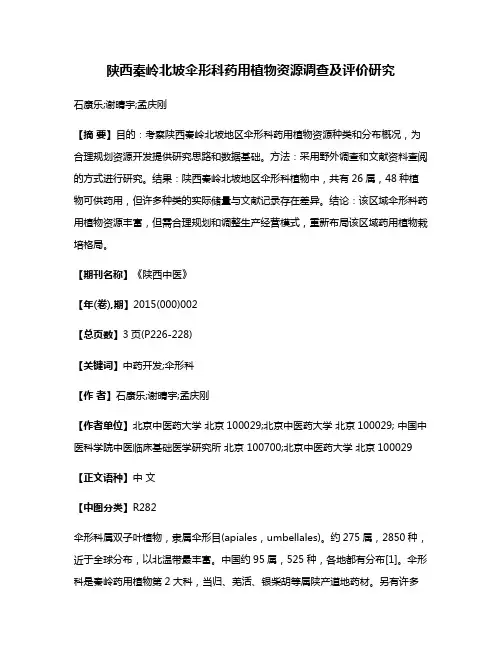
陕西秦岭北坡伞形科药用植物资源调查及评价研究石康乐;谢晴宇;孟庆刚【摘要】目的:考察陕西秦岭北坡地区伞形科药用植物资源种类和分布概况,为合理规划资源开发提供研究思路和数据基础。
方法:采用野外调查和文献资料查阅的方式进行研究。
结果:陕西秦岭北坡地区伞形科植物中,共有26属,48种植物可供药用,但许多种类的实际储量与文献记录存在差异。
结论:该区域伞形科药用植物资源丰富,但需合理规划和调整生产经营模式,重新布局该区域药用植物栽培格局。
【期刊名称】《陕西中医》【年(卷),期】2015(000)002【总页数】3页(P226-228)【关键词】中药开发;伞形科【作者】石康乐;谢晴宇;孟庆刚【作者单位】北京中医药大学北京100029;北京中医药大学北京100029; 中国中医科学院中医临床基础医学研究所北京 100700;北京中医药大学北京100029【正文语种】中文【中图分类】R282伞形科属双子叶植物,隶属伞形目(apiales,umbellales)。
约275属,2850种,近于全球分布,以北温带最丰富。
中国约95属,525种,各地都有分布[1]。
伞形科是秦岭药用植物第2大科,当归、羌活、银柴胡等属陕产道地药材。
另有许多民间应用广泛的草药,如:变豆菜、峨参、破子草、鸭儿芹等 [2] 。
目前,国内对伞形科药用植物少有区域性的药用植物资源实地考察,及在此基础上进行的资源评价和开发利用建议。
导致药用植物资源本底不清, 严重制约了该类群的开发利用。
本文在对陕西秦岭北坡药用植物资源分布及利用现状进行实地调研的基础上,对资源储量、区域分布、海拔分布进行分析研究, 以期为山区农业结构调整、种植业布局等提供理论与实践依据参考。
根据实地调查,结合相关文献及标本资料,整理出全球伞形科植物约260余属,2000余种,分布于北温带、亚热带或热带的高山上。
秦岭有37属,91种,16变种,2变型;陕西秦岭北坡分布有28属,69种;其中26属,48种具有药用价值。
中国植物一新记录属——聚药罗伞属(报春花科)
黄戈晗;郝刚;胡启明
【期刊名称】《热带亚热带植物学报》
【年(卷),期】2017(025)003
【摘要】首次发现报春花科(Primulaceae)聚药罗伞属[Hymenandra(A.DC.)]及其模式种——聚药罗伞[H.wallichii(A.DC.)]在中国的分布.据已有文献记载,此种仅分布于印度、孟加拉国和缅甸.最近在中国科学院昆明植物研究所标本馆(KUN)查阅标本时,在原鉴定为紫金牛属的标本中发现了数份采自我国云南的标本实为聚药罗伞,现予以报道.
【总页数】3页(P282-284)
【作者】黄戈晗;郝刚;胡启明
【作者单位】华南农业大学生命科学学院, 广州 510642;华南农业大学生命科学学院, 广州 510642;中国科学院华南植物园, 广州 510650
【正文语种】中文
【相关文献】
1.中国短月藓属植物一新记录种和真藓属一新记录变种 [J], 王晓宇;汪德秀
2.中国蚜科一新记录属斯维蚜属及一新种(同翅目:蚜总科) [J], 张丽坤;张广学
3.中国五加科植物的分类学研究: 罗伞属和鹅掌柴属的新种和新异名 [J], Porter P.LOWRY II;向其柏
4.中国粉孢革菌科一新记录属(白缘皱孔菌属)和一新记录种(拟软白缘皱孔菌) [J],
周绪申;姜俊清;刘桂芹;戴玉成
5.浙江桫椤科一新记录属(白桫椤属)和一新记录种(笔筒树) [J], 陈贤兴;潘太仲因版权原因,仅展示原文概要,查看原文内容请购买。
采自长白山的几个中国新记录伞菌图力古尔;刘宇【期刊名称】《菌物研究》【年(卷),期】2010(008)001【摘要】报道了采自吉林省长白山自然保护区的3个中国新记录伞菌,即紫褶小孢菌[Baeospora myriadophylla (Peck) Singer]、木生囊环菇[Cystolepiota lignicola (P. Karst.) Nezdojm.]和暗褶菌[Melanophyllum haematospermum (Bull.) Kreisel],并描述了1个中国大陆新记种黄褐色孢菌[Callistosporium luteo-olivaceum (Berk. & M.A. Curtis) Singer].Cystolepiota和Melanophyllum为中国新记录属.提供所有种的子实体照片和显微结构线条图.凭证标本存放于吉林农业大学菌物标本馆(HMJAU).【总页数】7页(P26-31,47)【作者】图力古尔;刘宇【作者单位】吉林农业大学菌物研究所,长春,130118;鲁东大学生命科学学院,烟台,264025;鲁东大学生命科学学院,烟台,264025【正文语种】中文【中图分类】Q949.329.81【相关文献】1.长白山1中国新记录子囊菌——粉末核散孢盘菌 [J], 于文杰;秦立武;吴秀玲;陈庆红;刘凤霞;范宇光2.武夷山的三种中国新记录伞菌 [J], 刘燕;钱晓鸣3.中国新记录光藓科Schistostegaceae植物在长白山的发现 [J], 曹同;Bell.,RJ4.长白山伞菌中的外生菌根真菌 [J], 王敬恒5.松林丝盖伞——一个中国新记录伞菌 [J], 彭炜航; 于文杰; 李岩; 孙秋; 范宇光因版权原因,仅展示原文概要,查看原文内容请购买。
中国一新记录种——黑顶小皮伞
邓春英;李泰辉
【期刊名称】《菌物学报》
【年(卷),期】2008(27)5
【摘要】最近作者在检查中国科学院昆明植物研究所隐花植物标本馆(HKAS)小皮伞属Marasmius Fr.的标本时,发现了二份具大型子实体的标本,经鉴定它们与采
自美国的黑顶小皮伞M.nigrodiscus(Peck)Halling等模式标本(HKAS 39834)在宏观和微观特征上一致,为中国的新记录种。
颜色对照采用Kornerup &Wanscher(1978)的颜色手册描述。
现描述如下:
【总页数】3页(P768-770)
【作者】邓春英;李泰辉
【作者单位】中国科学院华南植物园,广州,510650广东省微生物研究所,广东省菌
种保藏与应用重点实验室,广州,510070;中国科学院研究生院,北京,100049;广东省
微生物研究所,广东省菌种保藏与应用重点实验室,广州,510070
【正文语种】中文
【中图分类】S6
【相关文献】
1.恩蚜小蜂属1中国新记录种及1大陆新记录种记述(膜翅目:蚜小蜂科) [J],
耿慧;李成德
2.中国黑蓟马属一新记录种记述(缨翅目:黑蓟马科) [J], 杨淑兰;MAJID
Micrab-balou;童晓立
3.西昆仑黑伞顶新近纪次火山岩地球化学特征及成因 [J], 张祥信;陈必河
4.中国松塔牛肝菌属,假黑伞属和黑伞属的新记录种 [J], 孙英华;徐优良
5.小皮伞科1中国新记录种——白毛丛梗霉皮伞 [J], 刘礼跃;于文杰;郑海婷;罗玉梅;长城;邓伦莎;范宇光
因版权原因,仅展示原文概要,查看原文内容请购买。
宁夏3种新记录植物谭鹏;吴中梅【摘要】According to field work and the identification of the samples,three newly recorded plants are reported:Stachys chinensis Bunge ex Bench.,Eclipta prostrata(L.)L.,Euphorbia maculata Linn and Marsilea quadrifolia L. This has an important significance for studying the flora of Ningxia province.%通过野外采集和室内鉴定,发现宁夏回族自治区3个新记录植物——鳢肠(Eclipta prostrata(L.) L.)、斑地锦(Euphorbia maculata Linn)和苹(Marsilea quadrifolia L.),对研究宁夏植物区系及这些植物的地理分布具有重要意义.【期刊名称】《农业科学研究》【年(卷),期】2015(036)003【总页数】3页(P22-24)【关键词】宁夏;鳢肠;斑地锦;苹;新记录【作者】谭鹏;吴中梅【作者单位】宁夏银川市湿地管理办公室,宁夏银川 750021;宁夏银川市湿地管理办公室,宁夏银川 750021【正文语种】中文【中图分类】Q949宁夏3种新记录植物谭鹏,吴中梅(宁夏银川市湿地管理办公室,宁夏银川750021)摘要:通过野外采集和室内鉴定,发现宁夏回族自治区3个新记录植物——鳢肠(Eclipta prostrata(L.)L.)、斑地锦(Euphorbia maculata Linn)和苹(Marsilea quadrifolia L.),对研究宁夏植物区系及这些植物的地理分布具有重要意义.关键词:宁夏;鳢肠;斑地锦;苹;新记录中图分类号:Q949文献标志码:A文章编号:1673-0747(2015)03-0022-03收稿日期:2015-05-22作者简介:谭鹏(1969—),女,高级林业工程师,主要从事园林植物病虫害防治及湿地管理研究.2014—2015年,银川市湿地管理办公室对宁夏银川市的湖泊湿地进行植物种类调查时,采集到菊科植物鳢肠、苹科植物苹和大戟科植物斑地锦,这3种植物在宁夏植物志都没有收录[1].所有标本物证存放在银川市湿地管理办公室湿地植物标本室.1 鳢肠(图1)图1 鳢肠植株Eclipta prostrata(L.)L.,Mant. 2: 286. 1771;Hand. - Mazz.,Symb. Sin. 7: 1109. 1936;Kitam. in Mem. Coll. Sci. Kyoto Univ. ser. B. 16: 266. 1942;裴鉴等,江苏南部种子植物手册763.图1228. 1959.——Verbesina prostrata L. Sp. Pl. 902. 1753,ed 2. 1227. 1763.——Verbesina alba L.,l. c.——Eclipta ereta L.,Mant. 2: 286. 1771;Lour.,Fl. Cochinch. 505. 1790;Chen in Bull. Fam. Mem. Inst. Biol. 5: 55. 1934.——Eclipta thermalis Bunge in Mem. Acad. Sci. St. Petersb. Sav. Etrang. 2: 113. 1833.——Eclipta alba (L.)Haask.,Pl. Jav. Rav. 528. 1848;Benth.,Fl. Hongk. 181. 1861;Franlch.,Pl. David. 165. 1884;Forbies et Hemsl. in Journ. Linn. Soc. Bot. 23: 433. 1888;Komar.,Fl. Manch. 3: 629. 1907;Hayata,Comp. Formos. 17. 1904 et Ic. Pl. Formos. 8: 59. 1919;Merr. in Lingn. Sci. Journ. 5: 184. 1927;Ling in Contrib. Inst. Bot. Nat. Acad. Peip. 2: 489. 1934; Chang in Sunyats. 3: 292. 1937;Kitag.,Lineam. Fl. Mansh. 449. 1939;侯宽昭,广州植物志547. 1956;刘慎谔等,东北植物检索表383. 1959.——Eclipta marginata Boiss.,Fl. Orient. 3: 249. 1875;Debeaux in Act. Soc. Linn. Bordeaux31: 217. 1876.1.1分布与生境生于河边、田边或路旁.全草入药,有凉血、止血、消肿、强壮之功效.世界热带及亚热带地区广泛分布[2].宁夏首次发现在艾依河边.1.2标本查阅模式标本存于银川市湿地管理办公室湿地植物标本室.2 斑地锦(图2)图2 斑地锦植株Euphorbia maculata Linn. Sp. Pl. 455. 1753;Boiss. in DC. Prodr. 15(2): 46. 1862;Ohwi,Fl. Tap. 839. 1978;湖北植物志2: 386. 1979.——E. supina Raf. Amer. Month. Mag. 2: 119. 1817;Ohwi,Fl. Jap. 840. 1978;江苏植物志2: 412.图1407. 1982;J. S. Ma&C. Y. Wu in Collect. Bot. 21: 106. 1992.——Chamaesyce maculata(Linn.)Small,Fl. S. E. U. S. 713. 1903;Lin et al. in Bot. Bull. Acad. Sin. 32: 240. f. 15. 1991;台湾植物志ed 2,3: 439,pl. 229,1993.——C. supina(Raf.)Moldenke,Annot. Class. List. Moldenke Coll. 135. 1939.2.1分布与生境原产北美,归化于欧亚大陆;产于江苏、江西、浙江、湖北、河南、河北和台湾.生于平原或低山坡的路旁[3].宁夏首次发现在宁夏大学金波湖和燕鸽湖.2.2标本查阅模式标本存于银川市湿地管理办公室湿地植物标本室.2.3分种检索表3 苹(图3)Marsilea quadrifolia L. Sp. pl. 2: 1099. 1753;傅书遐,中国主要植物图说·蕨类植物门256.图. 344. 1957: Ic. Corm. Sin. 1: 283. f. 566. 1972;Fl. Tsinling. 2: 200. t. 50: 1- 3. 1974: Ching et al. in W. Y. Chun,Fl. Hainan. 1: 204. t. 101: 1- 2. 1964;B. Z. Ding et al.,Fl. Honan 1: 121,f. 141. 1981;Fl. Fujian. 1: 263. f. 249. 1982;S. H. Li et J. Z. Wang,Fl. Liaoning 1: 121,t. 52: 1- 2. 1988;C. Y. Yang,Fl. Xinjiang 1: 49. 1992;Nakaike,New Fl. Jap.Pterid. rev. et enlarg. 718. f. 718a- b. 1992;K. Iwats.,Ferns et Fern Allies Jap. 283. Pl. 195: 283. 1992;S. X. Xu in J. F. Cheng et G. F. Chu,Fl. Jiangxi. 1: 355. f. 369. 1993;Z. F. Zhang et S. Y. Zhang,Fl. Zhejiang 1: 334. f. 1- 356. 1993.图3 苹植株3.1分布与生境广布长江以南各省区,北达华北和辽宁,西到新疆.世界温热两带其他地区也有分布.生于水田或沟塘中,是水田中的有害杂草,可作饲料.全草入药,清热解毒,利水消肿,外用治疮痈、毒蛇咬伤[4].宁夏首次在艾依河边发现.3.2标本查阅模式标本存于银川市湿地管理办公室湿地植物标本室.参考文献:[1]马德滋,刘惠兰,胡福秀.宁夏植物志(第一卷和第二卷)[M].银川:宁夏人民出版社,2007.[2]中国科学院中国植物志编辑委员会.中国植物志(75卷)[M].北京:科学出版社,1979:344.[3]中国科学院中国植物志编辑委员会.中国植物志(44 卷3分册)[M].北京:科学出版社,1997:53.[4]中国科学院中国植物志编辑委员会.中国植物志(6 (2)卷)[M].北京:科学出版社,2000:337.Three new records of plant species in NingxiaTan Peng,Wu Zhongmei(Wetland Management Office,Yinchuan 750021,China)Abstract: According to field work and the identification of the samples,three newly recorded plants are reported: Stachys chinensis Bunge ex Bench.,Eclipta prostrata(L.)L.,Euphorbia maculata Linn and Marsilea quadrifolia L. This has an important significance for studying the flora of Ningxia province.Key words: Ningxia;Eclipta prosrata(L.)L.;Euphorbia maculata Linn;Marsilea quadrifolia L.;new records (责任编辑、校对魏乐)。
浙江省伞形科植物新资料梅爱君;马丹丹;谢文远;赵明水;徐卫南【摘要】2015年在浙江省天目山国家级自然保护区发现一个伞形科Apiaceae(Umbelliferae)浙江地理分布新记录属、种——山芎属Conioselinum Fisch.ex Hoffm.,山芎Conioselinum chinense(Linn.)Britton.%A new geographical distribution plant was found in 2015 in National Nature Reserve of Mount Tianmu, Zhejiang province. It is Conioselinum chinense (Linn.) Britton.【期刊名称】《浙江林业科技》【年(卷),期】2017(037)003【总页数】2页(P85-86)【关键词】山芎属;山芎;分布新记录;天目山;浙江【作者】梅爱君;马丹丹;谢文远;赵明水;徐卫南【作者单位】浙江省临安市林业局,浙江临安 311300;浙江农林大学暨阳学院,浙江诸暨 311800;浙江省森林资源监测中心,浙江杭州 310020;浙江天目山国家级自然保护区管理局,浙江临安 311311;浙江省临安市林业局,浙江临安 311300【正文语种】中文【中图分类】S567.23+9;Q949.4伞形科Apiaceae(Umbelliferae)的分类比较复杂,山芎属Conioselinum属芹亚科Apioideae前胡族当归亚族,全球约4种,我国约3种(山芎、鞘山芎C.vaginatum和台湾山芎C. morrisonense),产新疆、安徽、江西及台湾等省区。
山芎属的特点:茎圆柱形,具纵条纹;小总苞片多数,线形;花白色,萼齿不明显;分生果背棱狭翅状,侧棱成宽翅。
2015年在浙江省临安市珍稀植物调查中,发现了一种伞形科植物,根据其残存果实,确定为山芎属,后经查阅相关文献[1-4],鉴定其为山芎Conioselinum chinense (Linn.) Britton,属浙江地理分布新记录属和种,现报道如下。
Botanical Research 植物学研究, 2018, 7(4), 425-428Published Online July 2018 in Hans. /journal/brhttps:///10.12677/br.2018.74051A New Recorded Species of Apiaceae inChinaBin Shen, Binjie Ge*Shanghai Chenshan Botanical Garden, ShanghaiReceived: Jun. 23rd, 2018; accepted: Jul. 9th, 2018; published: Jul. 17th, 2018AbstractHeracleum sphondylium L. var. nipponicum (Kitag.) H. Ohba, which was found in Xiangshan County of Zhejiang Province, was reported here as a newly recorded species of Apiaceae in China. After careful identification, we treated this species in Sect. Heracelum, closed to H. moellendorffii Hance morphologically, but this species has 1-pinnate basal leaves, deeply lobed pinnae; oval fruit, later-al ribs with 1 mm wide wings.KeywordsNew Record, East China Sea, Costal Island, Apiaceae, Heracleum中国伞形科植物新记录沈彬,葛斌杰*上海辰山植物园, 上海收稿日期:2018年6月23日;录用日期:2018年7月9日;发布日期:2018年7月17日摘要本文报道了采自浙江省宁波市象山县中国新记录植物日本独活Heracleum sphondylium L. var. nippo-nicum (Kitag.) H. Ohba,经过标本鉴定与比对,作者认为该种隶属伞形科(Apiaceae)独活属独活组(Sect.Heracleum),与中国产的短毛独活(H. moellendorffii Hance)在形态上最为接近,但本种基生叶一回羽状,羽片中裂至深裂;果实椭圆形,侧棱的翅仅宽1 mm。
*通讯作者。
沈彬,葛斌杰关键词新记录,东海,近陆岛屿,伞形科,独活属Copyright © 2018 by authors and Hans Publishers Inc. This work is licensed under the Creative Commons Attribution International License (CC BY)./licenses/by/4.0/1. 引言我们在东海近陆岛屿植物资源调查过程中,于浙江省宁波市象山县韭山列岛采集到一种伞形科(Apiaceae Lindl.)植物,通过查阅国内外伞形科及独活属相关文献资料[1] [2] [3] [4],确认为芹亚科(Apioideae Drude)前胡族(Peucedaneae Drud)环翅芹亚族(Tordylieae Drude)独活组(Sect. Heracleum )的日本独活Heracleum sphondylium L. var. nipponicum (Kitag.) H. Ohba ,该种为中国分布新记录,现报道如下:日本独活 (伞形科) (图1)Heracleum sphondylium L. var. nipponicum (Kitag.) H. Ohba, J. Jap. Bot., 69(2): 119. 1994.—H. nippo-nicum Kitag. Rep. Inst. Sci. Res. Manchoukuo 2: 274. 1938; Ohwi, Fl. Jap. 686. 1965.Figure 1. Heracleum sphondylium L. var. nipponicum (Kitag.) H. Ohba (a) Root; (b) Stem; (c) Leaves; (d) Inflorescence; (e) Flowers; (f) Bracts; (g) Fruits图1. 日本独活。
(a) 根;(b) 茎;(c) 叶;(d) 花序;(e) 花;(f) 苞片;(g) 果实沈彬,葛斌杰1) 形态学特征多年生草本,高60~100 cm。
根圆锥形,分叉,淡褐色。
全株疏被白色细柔毛和短刺毛。
茎圆柱形,紫褐色,有纵沟纹,中空。
基生叶具长柄,基部有宽阔叶鞘,叶片轮廓阔卵形,一回羽状,侧生2对小叶,小叶宽卵形,羽状中裂至深裂,边缘有不整齐锯齿,基部楔形或心形,有柄,顶端裂片为宽三角形,较两侧叶片大,羽状中裂,基部心形,顶端锐尖;茎上部叶一回羽状,羽片3浅裂,叶柄基部具宽阔叶鞘,叶片较小,顶端锐尖。
复伞形花序顶生或侧生,直径11~32 cm,花序梗长6~27 cm;有总苞片,狭披针形,有长尾尖,早落;伞幅25~30,长7~14 cm;小伞形花序径3~5 cm;小总苞片线形,6~8,长3~8 mm;花瓣白色,二型;萼齿三角形;子房被毛;花柱基扁圆锥形,花柱棒状,叉开,长达子房1/3~1/2。
果实椭圆形,顶端略凹陷,长7~8 mm,宽5~6 mm,有稀疏的柔毛,背棱和中棱线不突起,侧棱有1 mm 宽的狭翅;每棱槽内有油管1,顶端细,向下渐粗,呈棍棒状,长短不一,可达果实1/2~2/3,合生面有油管2,延伸至果实中部。
花果期4~6月。
China (中国):Zhejiang Province (浙江省),Xiangshan Conuty (象山县),Jiushan Islands (韭山列岛),alt. 32 m,29˚25'36''N,122˚11'19''E,岩质海岸常绿落叶混交灌丛中2015-04-17,Binjie Ge (葛斌杰) GBJ04444 (NAS); 2015-05-28,同一种群,Xiyang Ye (叶喜阳) YXY201505001 (CSH)。
原记载特产于日本:本州(关东以西)、四国和九州。
中国分布新记录。
本种与分布于中国、日本和朝鲜半岛等地的短毛独活(H. moellendorffii Hance)相似,主要区别在于前者基生叶一回,羽片5,中裂至深裂;果实椭圆形,侧棱仅具1 mm窄翅。
2) 生境及群落特征日本独活生于岩质海岸常绿落叶混交灌丛中,其所处群落乔木层的常见建群种或伴生种主要有化香树Platycarya strobilacea、黑松Pinus thunbergii、天仙果Ficus erecta var. beecheyana、白背叶Mallotus apelta、楝Melia azedarach、全缘冬青Ilex integra;灌木层主要有海桐Pittosporum tobira、滨柃Eurya emarginata、柃木E.japonica、厚叶石斑木Rhaphiolepis umbellata、野蔷薇Rosa multiflora、檵木Loropetalum chinense等;草本层主要有山菅Dianella ensifolia、羊蹄Rumex japonicus、鸭嘴草Ischaemum aristatum var. glaucum、普陀狗娃花Aster arenarius、假还阳参Crepidiastrum lanceolatum、五节芒Miscanthus floridulus、刻叶紫堇Corydalis incisa、火炭母Polygonum chinense、葎草Humulus scandens、刺果毛茛Ranunculus muricatus等;层间层有茅莓Rubus parvifolius、千金藤Stephania japonica、滨海鸡矢藤Paederia scandens var. maritima、木防己Cocculus orbiculatus、葛麻姆Pueraria montana var. lobata等.2. 讨论本变种的发现将华东地区分布的独活属植物增至4种2变种[5] [6],对研究中国东西部独活属植物演替[7]和东亚海岛植物区系都有参考价值。
值得指出的是,中国-喜马拉雅地区是独活属环翅芹亚族主要的物种多样性中心,特别是横断山区快速的辐射演化,从宏观形态学角度,很难清晰地划定种间界限,华东地区虽然种类较少,但种间、种下关系的清晰厘定还需要结合分子生物学、形态学、细胞学开展进一步研究。
我们注意到,邱园最新发布的世界植物在线网站(Plants of the world online) [8]接受了韩国学者将日本独活处理为短毛独活异名的观点[9],但我们发现这部更新中的电子版专著,只是对已有的各大植物学数据库涉及到朝鲜半岛植物学名称的再梳理,未引证一篇类群处理的文献,因此我们对此处理存疑,仍承认日本独活。
独活属植物的根常含香豆精类物质,如欧前胡内酯、异茴芹香豆精、香柑内酯等,具有镇痛、抗炎、平喘等作用,民间常用于治疗感冒引起的头痛、咳嗽、鼻塞等[10]。
此外,该种是大型健壮草本,具备花量大、形态秀美、耐晒抗风等特点,具有潜在的园艺观赏价值,值得沿海省区植物园、公园绿地引种培育。
沈彬,葛斌杰基金项目中科院战略生物资源科技支撑体系运行专项植物园运行补助经费(ZSZY-001)。
参考文献[1]中国科学院中国植物志编辑委员会. 中国植物志: 第55卷第3分册[M]. 北京: 科学出版社, 1992: 181-212.[2]Pu, F.D. and Watson, M.F. (2005) Heracleum Linnaeus. In: Wu, Z.Y., Raven, P.H. and Hong, D.Y., Eds., Flora ofChina, Vol. 14, Science Press, Beijing & Missouri Botanical Garden, St. Louis, 195-203.[3]Iwatsuki, K., Boufford, D.E. and Ohba, H. (1993) Flora of Japan (Apiaceae). Vol. 2, Kodansha, Japan, 268-302.[4]Ohba, H. (1994) Infraspecific Taxa of Heracleum sphondylium L. and H. lanatum Michx. The Journal of JapaneseBotany, 69, 118-119.[5]田旗, 葛斌杰, 王正伟. 华东植物区系维管束植物多样性编目[M]. 北京: 科学出版社, 2014: 273.[6]李宏庆, 田怀珍. 华东种子植物检索手册[M]. 上海: 华东师范大学出版社, 2010: 236.[7]Yu, Y., Downie, S.R., He, X.J., Deng, X.L. and Yan, L. (2011) Phylogeny and Biogeography of Chinese Heracleum(Apiaceae Tribe Tordylieae) with Comments on Their Fruit Morphology. Plant Systematics and Evolution, 296,179-203.[8]/taxon/urn:lsid::names:978089-1[9]Chang, C.S., Kim, H. and Chang, K.S. (2014) Provisional Checklist of Vascular Plants for the Korea Peninsula Flora(KPF) (Version 1.0).[10]国家中医药管理局《中华本草》编委会. 中华本草: 第5册第15卷[M]. 上海: 上海科学技术出版, 1999: 957-965.1. 打开知网页面/kns/brief/result.aspx?dbPrefix=WWJD下拉列表框选择:[ISSN],输入期刊ISSN:2168-5665,即可查询2. 打开知网首页/左侧“国际文献总库”进入,输入文章标题,即可查询投稿请点击:/Submission.aspx期刊邮箱:br@。